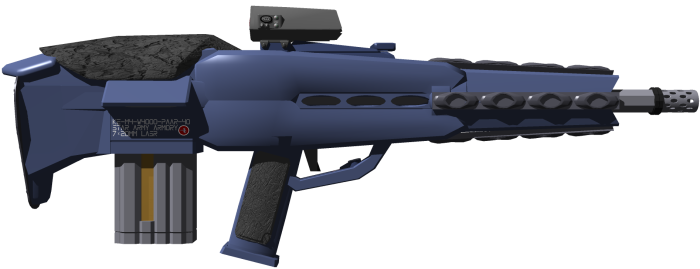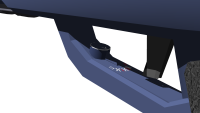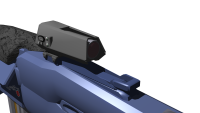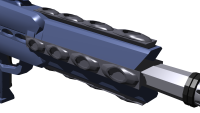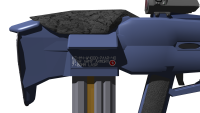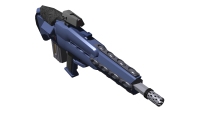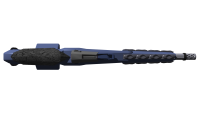Table of Contents
Ke-M4-W4000 Power Armor Automatic Rifle - 40YE
Produced by Ketsurui Zaibatsu, with units starting YE 40 to be field tested by selected Star Army of Yamatai forces. Currently a highly restricted weapon due to limited numbers and only being issued to designated units for testing purposes.
About the PAAR-40
Intended to serve as either a replacement or supplement to the Ke-M4-W2901 Light Armor Service Rifle, this weapon was meant to give a more robust and sturdy weapon frame for use with Power Armored personnel in the Star Army of Yamatai. Though some might consider the weapon to be in some ways merely a side-grade to the LASR, due to its differences in operation and use.
Beginning development in YE 36, originally intending to just be a rebuild of the Ke-M4-W2901 rifle to better sustain operational requirements, the design soon came into snags trying to replicate the design of the weapon improving where it needed it to be improved, without sacrificing features it already had. Due to this difficulty, it was decided this would instead be built as a new rifle, using the same 7x20mm ammunition (to avoid having to design new ammunition as well as use already existing stockpiles) as the Mark II Variant. This ensures the weapon has the heavier impact of the MKII LASR. The main difference between the two weapons is purpose. The Ke-M4-W4000 is intended to be a weapon capable of operating in multiple roles akin to the MKI LASR, but also have the ability to perform at the same level as the MKII, if not as effectively.
Field testing of this weapon has begun in YE 40, but it has not yet begun to be issued in bulk.
Nomenclature Information
Owing its nature, the Power Armor Automatic Rifle - 40YE is be treated as an alternative for the LASR, and due to this, maintains some touch of its legacy to the older weapon.
- Manufacturer: Ketsurui Zaibatsu
- Name: PAAR-40 [Power Armor Automatic Rifle - 40YE]
- Nomenclature: Ke-M4-W4000
- Type: Caseless Chemical Projectile Propulsion
- Role: Power Armor light assault weapon intended to provide a anti-infantry/light armor weapon.
- Length: 993.14 mm (39.1 in)
- Height: 167.19mm (6.5 in)
- Width: 120.96mm (4.7 in)
- Mass: 26.33 kg (58.04 lbs)
Appearance
While not as sleek in design as most Yamatai weapons, the PAAR-40 makes up for this flaw in its ease of operation. The design was meant for being able to be handled by troops in the field should issues arise. This means that while the sleek form would have been more comfortable to use for those handling the weapon, the more bulkiness allows the user to better handle it roughly without concern. The magazine is loaded into the weapon in a bull-pup configuration, helping to reduce the length of the weapon to help facilitate close quarters operational use. The stock, which houses the rotating bolt, has two ports for ejection of gases and unfired cartridges, with locks built in to allow the user to define which side of the weapon the ejection would occur. This, added to the mostly ambidextrous safety and firing mode lever built into the finger guard of the weapon, makes it much more friendly to operators who may not be naturally right-handed. The weapon camera is mounted above the charging handle, which is located atop the weapon's frame and the lever is first lifted to connect the handle to the charging rod before being pulled back a distance, with a few controls on the camera to allow for use when not combined with any power armor's built in camera systems. The hand-guard is an odd part to some in the design, owing the Type 40 Yamatai Integrated Rail System where attachments could be added, helping to further improve its adaptability.
Weapon Operational Information
Operating with a chemical propellant as opposed to a magnetic rails, results in very different handling and firing patterns in comparison to the LASR. The following below help to clarify these differences.
Discharge Information
One key difference lies in the matter of how the weapon sounds and looks when fired. No longer limited to the mere breaching of hte sound barrier by the firing of the weapon, those using the weapon need account for these facets. This is also in inclusion of weapon recoil and range differing significantly with the use of an alternate delivery method.
- Muzzle Flash: A quick gout of flame that is dispersed by the facets of the flash-hider, giving the weapon a thin, almost faint 'halo' like muzzle flash coming out of the end.
- Retort: When used in full automatic fire, the sound is akin to a un-suppressed motor engine running, though single and burst fire tend to make it sound more like a sharp pop of noise.
- Effective Range Up to 6000 meters (max range 18000 m in atmosphere)
- Rate of Fire: 800 RPM
- Recoil: Heavy. An unarmored non-Neko soldier attempting to fire this weapon would receive a significant kick to their shoulder. An NH-17R or NH-27 could fire the weapon up to a certain point, but not at full automatic for extended periods. A Nekovalkyrja, type 33 would be no different in this respect from NH-17 or NH-27's. Weapon drifts up, at a rate of one centimeter per 3 round burst. The direction left or right depends on which direction the weapon is set to vent. The drift from this is only noticeable in longer burst. This drift of 1 centimeter in the appropriate direction requires a burst of 15 rounds to occur.
Ammunition
In comparison to the the standard delivery method of the LASR MK.II rifle, which fires the 7x20mm darts via a magnetic rail system, the PAAR-40 instead encases the ammo in a stable plastic explosive propellant, which requires the centering cap to be removed. It is due to these differences that the PAAR-40's ammunition may not have as much muzzle velocity, as the chemical propellant is unable to generate as much force as the rail system. It also means that the ammunition takes up more room in storage and the magazines, as the ammunition is encased in blocks of propellant which, while able to store more cleanly due to their box-like form, take the room that 2 or even 3 darts would on their own.
While the propellant could be compared readily to plastic explosives, the amount and composition of it is such that the blast is more controlled, which can only be detonated with an electrical charge. With the nature of the bolt both in material composition and shape to house the cartridge prior to firing, this thusly not enough to cause damage to the bolt or other internal systems. This thusly helps give the PAAR-40 its reliable operation, and low-risk of cook-off as the rounds in the magazine lack the electrical charge to detonate the propellant.
- Ammunition Ke-M4-W2901 7×20mm LASR Type B
- Purpose: Tier 3 Offensive - Heavy Anti-Infantry Weapon
- Round Capacity: 30 rounds per magazine.
| Firing Modes | |
|---|---|
| Mode | Count |
| Safe | Weapon unable to fire |
| Semi-Automatic | Fires 1 round per trigger pull |
| 3-Round Burst | Fires 3 rounds per trigger pull |
| Full Automatic | Fires as long as trigger is held |
- Ammunition Description: A plain light or dark-grey boat-tail tapered dart with a colored tip.
- Standard: Round is made of steel, fitted with a Durandium Alloy jacket. The standard issue type of round, used for majority of engagements.
- Hollowpoint: Round is made of soft steel with hollow tip, fitted with a thin Durandium Alloy half-jacket. Intended for use in close quarters operations and/or against unarmored targets.
- Armor Piercing: Round is made of Durandium Alloy, with a Zesuaium dart core. Intended for use against lightly armored units such as general purpose military vehicles and light power armor/mecha forces.
- Tracer: Round is made of a hollow steel round, fitted with a Durandium Alloy jacket. Packed with slow-burning magnesium. 0.01 second delay on fuse to ignite magnesium. Used for night time operations to assist in tracking fire in dark conditions.
- Training: Round is made of hardened plastic, fitted with a steel jacket. Unlike with the LASR, PAAR-40 uses an altered training round, intended to provide all the impact and recoil standard in the weapon with standard ammo, but at much reduced ranges to allow for more controlled conditions on the range. Maximum range for these is 1000m, with ballistics identical to standard at 250m. This is due to the different firing mechanisms between the LASR and the PAAR-40, requiring training weapons to actually fire the rounds instead of being set to a 'training' mode that simulates the firing.
- High Explosive: Round is made of tungsten, fitted with a Durandium Alloy jacket, and a Type 31 Explosives core. Primarily issued to designated marksmen and sniper teams, these rounds are intended to serve as a means to quickly terminate targets.
Weapon Mechanisms
Using a rotating bolt, the weapon must make sure each of the follow components are in working form. Outside the firing pins and camera, the weapon uses a large amount of mechanical actions to operate, which help to reduce difficulty in operation and allow for more effective repairs in the field by even those without armory training.
- Firing Mechanism: Round is loaded into the weapon via a coil spring pushing rounds up from inside the magazine to feed into the bolt. Bolt is a rotating space with two slots (top/bottom to allow the bullet to feed in, and to allow heat and unfired ammo to be vented/ejected) for bullets to be housed. At rear of 'bolt' is a pair of electrical prongs that function similar to a remote blasting cap for plastic explosives. An electrical charge is used to ignite the propellent, which fires the bullet. The bolt then rotates to the 'port' that is enabled to vent heat while loading the next round. In the cases of misfires, the charging handle can be used to force a cycle of the bolt to eject the unfired round in the same fashion as the heat as the bolt rotates, open end reaching the port, and the bullet 'falling' out with help of a spring on the 'closed' opposite port.
- Loading: Magazines are loaded into the weapon in a bull-pup configured system from the bottom, locked into place with a notch to hold the ammo in. Ejection of the magazine is done via lever at the magazine well (or optional forward release, must be installed by armorer to ensure proper operation). Internal battery for firing system and weapon camera is standard BR-28 Series Battery Magazine, which should be replaced after every engagement (Defined as singular mission operation such as patrol or assault), 75,000 shots, or 48 hours of active use, whichever occurs first.
- Mode Selector: Located on the bottom of the trigger guard, the fire selection switch (which includes the safety) is operable by the user's trigger finger. Due to its central position on the guard, it is a more natural ambidexterous fire selection switch, though it still has a slight left-handed bias as the settings are, from left to right, with Safe being on the far left, Semi-Auto (Notated as 1), Burst Fire (Notated as 3), and Full-auto (notated as F) on the far right.
- Firing Modes: When not on safe, the weapon is capable of firing in one of three modes - Semi-Automatic, Three-Round Burst, and Fully Automatic.
- Weapon Sight: Standard Sighting system is a weapon mounted camera unit with built in scope capabilities. Due to PA link systems, view of the weapon's angle of attack when used is feed to users HUD. This however is an approximation of the area of impact with no outside forces affecting the weapon. Such a system allows the user to fire around corners with little risk of exposing themselves in the process.
- Attachment Hard Points: The sighting system can be replaced to allow for non-camera operated use, though it is advised to have a qualified Armorer perform the change so as to ensure proper alignment and stability of the alternate sight. In addition, the PAAR-40 has a newly designed Type 40 Yamatai Integrated Rail System to allow for installing of attachments such as foregrips, laser aiming devices, flash-lights, alternate weapon systems (shotgun or grenade launcher being common choices).
